Services on Demand
Journal
Article
Indicators
-
 Cited by SciELO
Cited by SciELO -
 Access statistics
Access statistics
Related links
-
 Similars in
SciELO
Similars in
SciELO
Share
Revista de Ciências Agrárias
Print version ISSN 0871-018X
Rev. de Ciências Agrárias vol.39 no.4 Lisboa Dec. 2016
https://doi.org/10.19084/RCA16090
ARTIGO
Comparative analysis of iron deficiency chlorosis responses in soybean (Glycine max) and barrel medic (Medicago truncatula)
Análise comparativa das respostas à clorose por insuficiência de ferro em soja (Glycine max) e luzerna-cortada (Medicago truncatula)
Carla S. Santos1,*, Inês Serrão e Marta W. Vasconcelos
1 Universidade Católica Portuguesa, Escola Superior de Biotecnologia, CBQF - Centro de Biotecnologia e Química Fina – Laboratório Associado, Rua Arquiteto Lobão Vital, Apartado 2511, 4202-401 Porto, Portugal. *E-mail: cssantos@porto.ucp.pt
ABSTRACT
Legume grains have an important socio-economical role, being highly utilized in human and animal nutrition. Although iron (Fe) is abundant in the earths crust, its limited solubility makes it poorly bioavailable for plants, contributing to iron deficiency chlorosis (IDC). In this work the physiological and molecular mechanisms associated with IDC were studied, namely, the mechanisms involved on Fe deficiency response, as well as a new Fe metabolism related gene in two important legume crops, Glycine max and Medicago truncatula. Fe deficient plants developed: decreased root and shoot length, increased number of secondary roots and lower chlorophyll levels. Fe shoot content decreased six- and 11-fold for G. max and M truncatula in Fe-deficiency. Whilst in G. max roots no significant differences were detected, in M. truncatula roots Fe decreased nine-fold in Fe-deficiency. Genes involved in Fe uptake (FRO2-like and IRT1-like), were over-expressed in roots of Fe-sufficient G. max and in Fe-deficient M. truncatula. VIT1-like, YSL1-like and ferritin presented higher expression levels in Fe-sufficient shoots and roots, whereas NRAMP3-like and GCN2-like showed higher expression values in Fe-deficiency.
Key Words: Ferric reductase, Glycine max, Medicago truncatula, qqmorphological analysis, RT-PCR.
RESUMO
As leguminosas têm um importante papel socio-económico, pela sua utilização na nutrição humana e animal. Apesar do ferro (Fe) ser um elemento abundante na crosta terrestre, a sua solubilidade limitada diminui a disponibilidade para as plantas, contribuindo para o desenvolvimento da Clorose por Insuficiência de Ferro (CIF). No presente trabalho, mecanismos fisiológicos e moleculares associados à CIF foram estudados, nomeadamente, os mecanismos de resposta à insuficiência de Fe e um novo gene associado ao metabolismo do Fe, em duas espécies cultivadas com relevância económica, Glycine max e Medicago truncatula. Plantas deficientes em Fe apresentaram: tamanho diminuído, maior número de raízes secundárias e baixos níveis de clorofila. Em insuficiência de Fe, o conteúdo de Fe na parte aérea diminuiu seis e onze vezes para G. max e M. truncatula, respetivamente; nas raízes de G. max não houve diferenças significativas e nas de M. truncatula o conteúdo de Fe diminuiu nove vezes. Genes envolvidos na absorção de Fe (FRO2-like e IRT1-like) foram sobre-expressos nas raízes de G. max em suficiência de Fe e, nas raízes de M. truncatula, quando em insuficiência. VIT1-like, YSL1-like e ferritina apresentaram níveis de expressão mais elevados em suficiência de Fe, ao contrário dos genes NRAMP3-like e GCN2-like, cuja expressão foi aumentada em insuficiência de Fe.
Palavras-chave: Análise morfológica, luzerna-cortada, reductase férrica, RT-PCR, soja.
Introduction
Legumes represent one of the most important foods, for both humans and animals (Vasconcelos and Grusak, 2006), providing an important source of protein and oil (Libault et al., 2010). One of the worlds top commodity production is soybean (Glycine max L.). In fact, much of the worlds protein and oil comes from soybean and this legume contains more protein (40%) and oil (20%) than any other ordinary food source, including meat, cheese and fish (Krishnan, 2005; Bolon et al., 2010). The appropriate addition of soy to different products, results in lower calorie alternative food products, with high content of protein, dietary fiber and minerals, preserving the physical and sensory characteristics of the product (Dhingra and Jood, 2001). The genome of soybean was sequenced, assembled and published (Schmutz et al., 2010), making it a good model crop to study genetic and molecular mechanisms. Barrel medic (Medicago truncatula) has been chosen as a model species for molecular studies in view of its growth and genomic characteristics (Trieu et al., 2000). To be convenient as a model for legume genomics, it is also essential that M. truncatula exhibit genome conservation with other crop legumes. Detailed comparisons between M. truncatula and M. sativa – a high feeding value crop used in animal nutrition – have reported that marker relationships were uniformly syntonic and that genes from M. truncatula share very high sequence identity to their counterparts from M. sativa, so it serves as an excellent model organism for soybean and other economically important legumes (Bell et al., 2001; Choi et al., 2004).
Besides protein and oil, legumes are also an important source of micronutrients, such as iron (Fe) (Vasconcelos and Grusak, 2006). This mineral is involved in the production of chlorophyll, and is also a component of many enzymes associated with the antioxidant system, energy transfer and nitrogen reduction and fixation. Legumes are very susceptible to Fe deficiency, when grown in adverse conditions, like calcareous soils, due to the low solubility of the oxidized form of Fe (Fe3+) at near neutral and alkaline soil pH (Waters et al., 2002; Andaluz et al., 2009). Insufficient Fe uptake leads to Fe-deficiency chlorosis (IDC) symptoms, such as yellowing of the younger leaves, interveinal chlorosis and stunted growth, as well as reduction of crop yields (Prasad, 2003; Kim and Guerinot, 2007). IDC lowers the concentrations of Fe in the seeds and other harvested tissues (Grusak, 1999), affecting both farmer profit and the nutritional value of plant products (Vasconcelos and Grusak, 2013).
In order to uptake Fe from the soil, dicotyledonous plants such as soybean and barrel medic, utilize Strategy I, where Fe3+ is reduced to Fe2+ through the action of a membrane-bound Fe3+-chelate reductase, like the ferric reduction oxidase (FRO). Fe2+ is then transported into the plant by specific membrane transporters (Grotz and Guerinot, 2006), such as the Iron-Regulated Transporter 1 (IRT1) (Waters et al., 2002). A broad spectrum of transporters have been characterized, such as the Natural Resistance Associated Macrophage (NRAMP) proteins, involved in Fe import into the cytoplasm, the Vacuolar Iron Transporter (VIT), involved in the uptake of Fe2+ into the vacuole for storage (Brear et al., 2013), and the Yellow Stripe 1-Like (YSL), involved in the transport of Fe2+-NA complexes (Kim et al., 2006). Free Fe is toxic since it facilitates the generation of highly reactive oxygen species (ROS). ROS can damage cellular constituents and, therefore, Fe homeostasis needs to be strictly controlled to avoid iron deficiency and toxicity (Liao et al., 2012). Therefore, storage proteins, such as Ferritin, play an important role in iron homeostasis, since they assure that ferric Fe is bio-available in case of cellular needs but yet nonreactive with oxygen (Briat et al., 2010).
Even though much has been learned about the physiology of Fe uptake in Arabidopsis, there is still a limited understanding of the physiology of tolerance to Fe deficiency in soybean and barrel medic, and this has hampered breeding programs (Vasconcelos and Grusak, 2013). There have been few works focusing in the comparative study between these two species (Yan et al., 2004), however more information is needed to understand the mechanisms at a molecular level, such as which genes have been selectively conserved or lost between both species. Since increasing the Fe uptake in the roots can augment Fe concentrations in the leaves, it is possible that some of this additional Fe may be remobilized to the grains, which would help in biofortification efforts that aim at enhancing Fe seed levels (Santos et al., 2013, 2015). However, the increased Fe translocation from shoots to seeds still remains one of the major bottlenecks in most biofortification programs (White and Broadley, 2005), and the answer to this may be in the identification of new candidate genes. GCN2 is a protein kinase present in several organisms such as mammals and yeasts (Lageix et al., 2008) and is activated in plants by amino acid deprivation conditions (Zhang et al., 2008), as well other stress stimuli, such as purine deprivation, UV light, cold shock and wounding (Lageix et al., 2008). To this date, there are no published studies on the role of GCN2 on Fe uptake in plants growing in Fe deficiency, which makes the study of this gene an important innovation in Fe nutrition in plants. However, its regulation is still not well known (Liu et al., 2015), which makes it relevant to study this gene, in order to understand how its expression if affected by Fe deficiency and which mechanisms it may be associated with.
The present study describes the common mechanisms underlying the response to Fe deficiency at a physiological and molecular level, in G. max and M. truncatula grown hydroponically under Fe deficiency and Fe sufficiency. It also describes further analysis on the role of a novel candidate gene, GCN2, on Fe metabolism.
Materials and methods
Plant material and growth conditions
Medicago truncatula cultivar Luzerna revilheira and Glycine max cultivar Williams 82 were grown in a growth chamber (Aralab Fitoclima 10000EHF) with 16 h day / 8 h night photoperiod. The temperature was kept at 20 ºC during the light period, with 350 µmol s-1 m-2 of photon flux density, and at 18 ºC during the dark period, with 75 % of relative humidity. Seeds of M. truncatula and of G. max were germinated for seven days in the dark and then transferred to hydroponic solutions with 20 mM FeEDDHA (Fe+) or with no FeEDDHA (Fe-) supply. The standard solution for hydroponic growth of M. truncatula contained as macronutrients: 3 mM KNO3, 1 mM Ca(NO3)2, 0.5 mM MgSO4.7H2O, 0.5 mM NH4H2PO4, 0.75 mM K2SO4, 25 mM CaCl2; and as micronutrients: 25 mM H3BO3, 2 mM MnSO4, 2 mM ZnSO4.H2O, 0.5 mM CuSO4.H2O, 0.5 mM MoO3, 0.5 mM NiSO4. The conditions used for G. max included as macronutrients: 1.2 mM KNO3, 0.8 mM Ca(NO3)2, 0.3 mM MgSO4.7H2O, 0.2 mM NH4H2PO4, 25 mM CaCl2; and as micronutrients: 25 mM H3BO3, 0.5 mM MnSO4, 2 mM ZnSO4.H2O, 0.5 mM CuSO4.H2O, 0.5 mM MoO3, 0.1 mM NiSO4. Both hydroponic solutions were buffered by the addition of 1mM MES, pH 5.5. The assay ended at the 14th day of hydroponic growth.
Morphological and biochemical evaluations
At the end of the experimental time period, five plants of each species and treatment were harvested and the length and fresh weight of shoots and roots was measured. Also, the number of secondary roots was counted and the chlorophyll concentration was quantified accordingly to Abadía et al. (1984).
Fe reduction was measured in the roots of five intact plants via the spectrophotometric measurement of Fe2+ chelated to BPDS, as described in Vasconcelos and Grusak (2006). Rates of reduction were determined using the molar extinction coefficient of 22.14 mM-1 cm-1. Roots and shoots were dried at 70 ºC and 200 mg of each sample was analyzed for the determination of Fe content using the ICP-OES Optima 7000 DV (PerkinElmer, Massachusetss, USA) with radial configuration, according to Roriz et al. (2014).
Gene expression analysis
Additional five replicates of each species and treatments were pooled and the RNA from leaves and roots was extracted following manufacturers instructions, using the Qiagen RNeasy Plant Mini Kit (USA, #74904). cDNA was synthesized using First Strand cDNA Synthesis Kit (Fermentas).
Candidate genes were selected according to their established (FRO2-like, IRT1-like, NRAMP3-like, VIT1-like, YSL1-like, ferritin) or possible (GCN2-like) role on Fe metabolism. In order to identify orthologs for these genes, known sequences from Arabidopsis were blasted, and the most homologous sequence (Evalue < 10-20) was selected (Table 1). Quantitative Real-Time PCR (qPCR) reactions were performed on a Chromo4 thermocycler (Bio-Rad). Amplifications were carried out using 1.25 µM of the specific primers and mixed to 12.5 µL of 2xPCR iQ SYBR Green Supermix (Bio-Rad) and 100 ng of cDNA in a final volume of 25 µl. Three technical replicates were performed for each gene tested in qPCR reactions, as well as for controls. The amplification of all genes was performed accordingly to Han et al. (2013). The comparative CT method (??CT) (Livak and Schmittgen, 2001) was utilized for the relative quantification of gene expression value of Fe stress related genes using the 18S rRNA gene as the housekeeping gene (Opticon Monitor 3 Software, Bio-Rad).
Results and Discussion
For several organisms, Fe represents a cofactor in vital metabolic pathways such as the electron transport chain of respiration. Plants have an additional need for Fe because photosynthesis and chlorophyll biosynthesis both require this micronutrient (Jeong and Guerinot, 2009). Thus, how plants maintain Fe homeostasis and the anatomical modifications concerning Fe absence is a biologically relevant question. In the current work, when Fe was absent, both G. max and M. truncatula behaved similarly, developing characteristic IDC symptoms, such as impaired growth, observed by the reduction in plant weight and length (Table 2). More specifically, G. max had 2.2- and 2.1-fold lower fresh weight in shoots and roots, respectively, under Fe deficiency, which was more pronounced than M. truncatula, that had a reduction of 1.5- and 1.8-fold (Table 2).
Another important characteristic associated with the absence of Fe is the development of secondary structures. Here, plants submitted to -Fe conditions showed swelling of root tips and increased number of secondary structures, namely, an average of 60 % more for G. max and 69 % more for M. truncatula (Table 2). The increased number of secondary structures helps the plant in augmenting the absorbable area for Fe uptake, and the scavenging of Fe in the rhizosphere (Schmidt, 1999). Since the surface of root hairs can represent up to 70% of the total root surface area (López-Bucio et al., 2003), the relevance of root hairs in nutrient uptake is crucial.
At the shoot level, the absence of Fe is known to inhibit chloroplast biogenesis and chlorophyll biosynthesis, leading to the development of chlorosis, especially in younger leaves (Henriques et al., 2002). Also, Fe starved plants may be more prone to oxidative damage (Kumar et al., 2010), leading to the accumulation of ROS, to oxidative stress, and to lower chlorophyll levels and increased chlorosis symptoms (as seen in Figure 1).
In this work, chlorosis symptoms appear to be more severe in G. max plants when compared to M. truncatula plants (Figure 1A), but the absolute values of chlorophyll concentration in Figure 1B seem to be contradictory. However, this is due to the fact that G. max plants, even under Fe sufficiency, werent as green as M. truncatula plants under the same treatment, leading to an acuter decrease in chlorophyll concentration.
Root Fe uptake capacity is linked with the solubilisation of Fe in the rhizosphere by the plants root Fe reductase activity, which is necessary to convert the less soluble Fe3+ to the more soluble Fe2+ (García et al., 2013). Here, for both species, the enzyme was more active in Fe+ conditions and was higher in M. truncatula plants (Figure 2). It has been hypothesized that, for some genotypes, Fe is necessary for the functioning of the reductase enzyme itself (Blair et al., 2010). Although most studies imply that Fe reduction is induced under Fe deficiency (Wang et al., 2013; Zha et al., 2014), it has already been described that this is not always this way (Vasconcelos and Grusak., 2006; Santos et al., 2015).
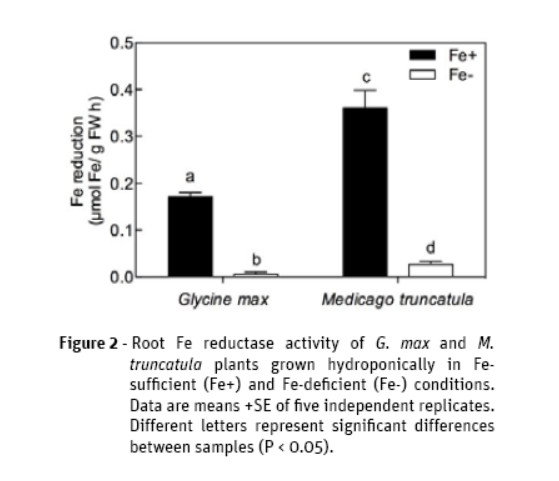
In order to understand how Fe deficiency affects the mineral composition of Fe in G. max and M. truncatula, root and shoot tissues were analyzed by ICP-OES. When G. max was faced with the lack of Fe, it appeared to accumulate its internal Fe storage in the roots and the shoot Fe content decreased six-fold (Figure 3). It has been seen before that in response to shortage in mineral nutrition plants usually allocate more resources to the roots (Hermans et al., 2006; Santos et al., 2015). On the other hand, M. truncatula plants had a general reduction in Fe content in both tissues under Fe deficiency.
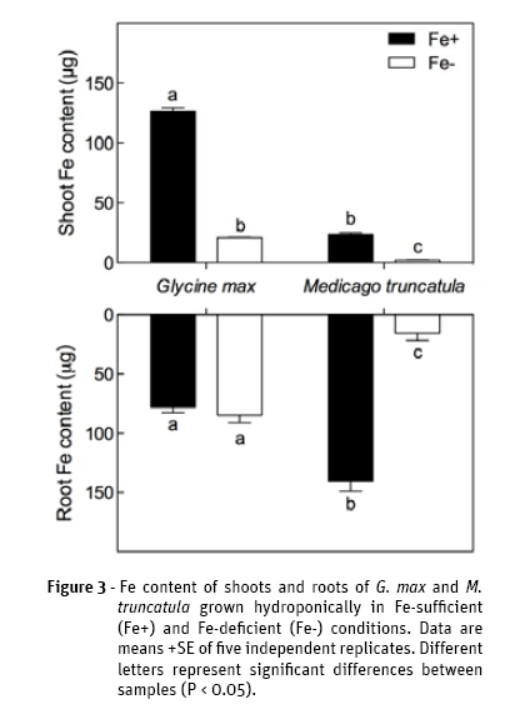
To further understand the mechanisms triggered by Fe shortage, it is crucial to comprehend the key conserved molecular players involved in nutrient uptake (e.g. FRO2 and IRT1), transport (e.g. NRAMP3, VIT1 and YSL1) and storage (e.g. ferritin), as well as identify novel candidate genes, that could have important roles in Fe metabolism (GCN2). When plants are faced with stress situations, the rate of nutrient uptake needs to increase, in order to compensate the lack of Fe. Thus, root Fe uptake related genes FRO2 and IRT1 are extremely important since they participate in this critical step concerning the plant response to Fe deficiency, and which control the efficiency of Fe uptake.
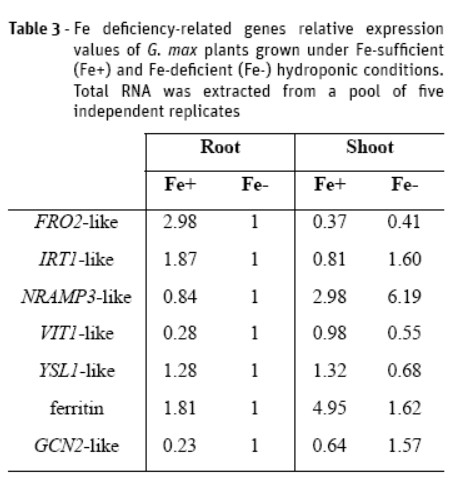
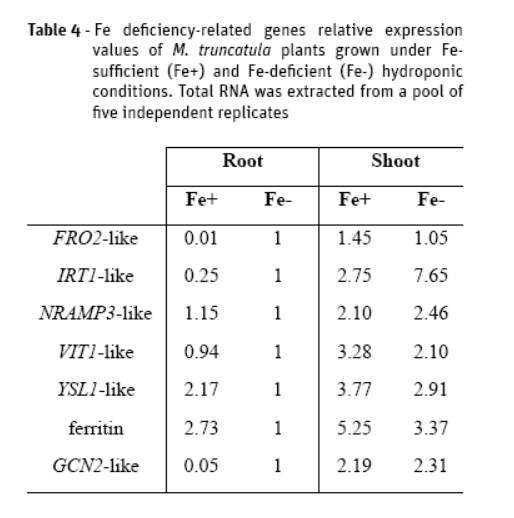
The results obtained for G. max plants show that in Fe- the expression of FRO2-like was decreased by three-fold (Figure 4), accordingly to the Fe reductase activity previously described (Figure 2). On the contrary, M. truncatula roots over-expressed FRO2-like gene under Fe deficiency (Figure 5), as previously obtained in A. thaliana (Robinson et al., 1999), tomato (Li et al., 2004) and soybean (Santos et al., 2016). When Fe was present in sufficient amounts, M. truncatula had almost null FRO2-like expression (Figure 5); since from the beginning of the trial, plants were in optimal conditions, they captured sufficient Fe to meet their daily requirements, thus inhibiting FRO2-like expression in order to avoid Fe toxicity. However, the Fe reductase activity was higher under Fe+ conditions (like in G. max). The Fe reduction is thought to be the rate-limiting step for Fe transport since Fe transporters, such as IRT1, do not reach saturation at normally achieved concentrations of Fe2+ (Grusak et al., 1990). If there is no Fe being reduced, IRT1-like should consequently present lower activity, which was clearly observed in G. max Fe- roots (Figure 4). In both species, the levels of IRT1-like expression were very similar to those obtained for FRO2-like (Figure 4 and 5), suggesting that IRT1-like is co-regulated with this gene, as previously seen in Arabidopsis thaliana (Vert, 2002; Kim and Guerinot, 2007).
After Fe is transported into the roots by IRT1, the transport of this nutrient across the plant is another crucial step that needs to be well known to efficiently develop an IDC mitigation or a biofortification strategy. Fe transporter families, such as VIT, NRAMP and YSL, are extremely important in Fe metabolism, as they assure that Fe is efficiently delivered to shoots, and other plant edible parts and storage organs. NRAMP3 and VIT1 have contrasting functions: while the first is responsible for the remobilization from the vacuole (Lanquar et al., 2005), the second is responsible for the Fe loading in the vacuole (Kim et al., 2006). Studies in A. thaliana demonstrate that NRAMP3 is an H+ metal symporter responsible for Fe and Mn remobilization from the vacuole, a crucial step during early seedling development (Lanquar et al., 2010). Accordingly, under Fe deficiency, as plants need more remobilization of Fe to respond to their needs, NRAMP3-like was more expressed (Figures 4 and 5) and VIT1-like was repressed, because plants activate VIT1-like in Fe sufficient conditions to increase Fe2+ uptake into the vacuole for storage purposes (Brear et al., 2013). Studies in A. thaliana (Kim and Guerinot, 2007) demonstrated that AtNRAMP3 and AtVIT1 mutants present arrested seedling growth when grown on Fe deficient soils. Moreover, Zhang et al. (2012) reported that the disruption of the rice VIT orthologues (OsVIT1 and OsVIT2) increased Fe and Zn accumulation in rice seeds and decreased Fe and Zn in the leaves.
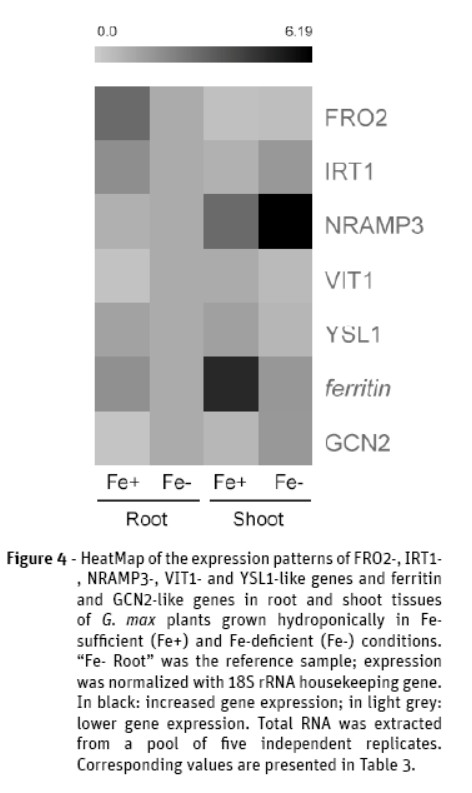
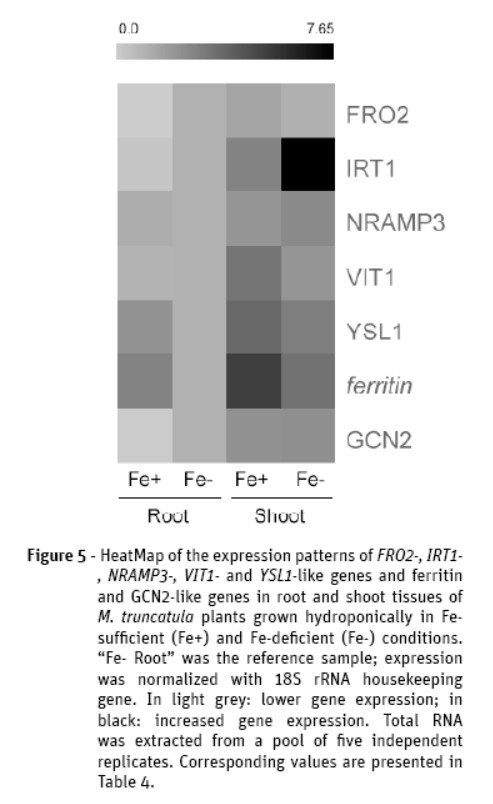
As well as NRAMP3-like and VIT1-like, the YSL1-like transporter may also play a crucial role in the control of the amount of Fe translocated to the seeds of G. max and M. truncatula. Both species had similar expression patterns (Figures 4 and 5), where both tissues presented higher levels in Fe+ conditions, suggesting a role in Fe translocation at diverse plant organs, as seen before (Kim et al., 2006). This gene is involved in the transport of the Fe2+-NA complexes (Kim et al., 2006) that are hypothesized as the main transportable Fe form in the phloem (Jean et al., 2005; Waters et al., 2006; Chu et al., 2010). Jean et al. (2005) used A. thaliana lines with a knock out mutation in AtYSL1, and the levels of NA and Fe in leaves and seeds decreased, as well as germination rates, even when plants were grown in Fe excess, showing that Fe and NA levels in seeds rely in part on YSL1 function.
Storage proteins such as ferritin play an important role in Fe homeostasis, assuring that Fe in excess is in a bio-available way in case of cellular needs but yet nonreactive with oxygen (Briat et al., 2010). Thus, the higher expression levels of this gene in Fe sufficient soybean and barrel medic plants are understandable (Figures 4 and 5) and are coherent with previous studies (Santos et al., 2016). This protein manages the insolubility and potential toxicity of Fe in the presence of oxygen, being involved in oxidative protection by sequestering free Fe (Lobreaux et al., 1995).
Even though several gene families are known to be involved in the Fe uptake mechanism, transport and storage, there are still many undiscovered genes that may have important roles in these processes. Therefore, it is worthwhile to find candidate genes that could have an important role in Fe metabolism. To this end, a novel gene was studied in the current work: GCN2-like. Both G. max and M. truncatula plants over-expressed GCN2-like under Fe deficient conditions (Figures 4 and 5), particularly at the root level, and it seems to indicate a role for GCN2-like in alleviating Fe stress, for both legume species. Lageix et al. (2008) showed that AtGCN2 was strongly activated following wounding and exposure to key hormones, and suggested that this enzyme plays a role in plant defense responses to insect pathogens, representing a key player linking biotic and abiotic stresses. Moreover, no studies have looked at the possible role of GCN2 and Fe nutrition, which highlights the importance of the current work. Further studies to link its role on Fe metabolism are under way.
The current work compared the responses of two legume species, soybean and barrel medic, to Fe deficiency. Taken together, the results described above suggest a conservation of anatomical and biochemical responses in the two legume species. Also, it is apparent that for genes such as FRO2-like and IRT1-like the regulation differs between these two legumes and is not conserved with other plants such as A. thaliana. It shows that generalizations in Fe uptake processes should not be lightly done. Finally, a novel sequence showing up-regulation under Fe deficiency was identified, opening doors to future studies looking at the role of this gene under Fe deficiency.
Acknowledgments
The authors would like to thank Prof. C. Pinto Ricardo for providing the Medicago truncatula cultivar Luzerna revilheira seeds and Mariana Roriz for the ICP analysis. This work was supported by National Funds from FCT through projects PEst-OE/EQB/LA0016/2013 and PTDC/AGRPRO/3972/2014, and PhD scholarship SFRH/BD/78353/2011.
References
Abadía, J.; Monge, E.; Montañes, L. and Heras, L. (1984) - Extraction of iron from plant leaves by Fe(II) chelators. Journal of Plant Nutrition, vol. 7, n. 1-5, p. 777-784. http://dx.doi.org/10.1080/01904168409363241 [ Links ]
Andaluz, S.; Rodríguez-Celma, J.; Abadía, A.; Abadia, J. and López-Millán, A.F. (2009) - Time course induction of several key enzymes in Medicago truncatula roots in response to Fe deficiency. Plant Physiology, vol. 47, n. 11-12, p. 1082-1088. http://dx.doi.org/10.1016/j.plaphy.2009.07.009 [ Links ]
Bell, C.J.; Dixon, R.A.; Farmer, A.D.; Flores, R.; Inman, J.; Gonzales, R.A.; Harrison, M.J.; Paiva, N.L.; Scott, A.D.; Weller, J.W.; and May, G.D. (2001) – The Medicago genome initiative: a model legume database. Nucleic Acids Research, vol. 29, n. 1, p. 114-117. http://dx.doi.org/10.1093/nar/29.1.114 [ Links ]
Blair, M.W.; Knewtson, S.J.B.; Astudillo, C.; Li, C.; Fernandez, A.C. and Grusak, M.A. (2010) - Variation and inheritance of iron reductase activity in the roots of common bean (Phaseolus vulgaris L.) and association with seed iron accumulation QTL. BMC Plant Biology, vol. 10, p. 215-2010. http://dx.doi.org/10.1186/1471-2229-10-215 [ Links ]
Bolon, Y.; Joseph, B.; Cannon, S.B.; Graham, M.A.; Diers, B.W.; Farmer, A.D.; May, G.D.; Muehlbauer, G.J.; Specht, J.E.; Tu, J.T.; Weeks, N.; Xu, W.W.; Shoemaker, R.C. and Vance, C.P. (2010) - Complementary genetic and genomic approaches help characterize the linkage group I seed protein QTL in soybean. BMC Plant Biology, vol. 10, art. 41. http://dx.doi.org/10.1186/1471-2229-10-41 [ Links ]
Brear, E.M.; Day, D.A. and Smith, P.M.C. (2013) - Iron: an essential micronutrient for the legume-rhizobium symbiosis. Frontiers in Plant Science, vol. 4, art. 359. http://dx.doi.org/10.3389/fpls.2013.00359 [ Links ]
Briat, J.F.; Ravet, K.; Arnaud, N.; Duc, C.; Boucherez, J.; Tourain, B.; Cellier, F. and Gaymard, F. (2010) - New insights into ferritin synthesis and function highlight a link between iron homeostasis and oxidative stress in plants. Annals of Botany, vol. 105, n. 5, p. 811–822. http://dx.doi.org/10.1093/aob/mcp128 [ Links ]
Choi, H.; Mun, J.; Kim, D.; Zhu, H.; Baek, J.; Mudge, J.; Roe, B.; Ellis, N.; Doyle, J.; Kiss, G.B.; Young, N.D.; and Cook, D.R. (2004) – Estimating genome conservation between crop and model species. Proceedings of the National Academy of Science of the USA, vol. 101, n. 43, p. 15289-15294. http://dx.doi.org/10.1073/pnas.0402251101 [ Links ]
Chu, H.H.; Chiecko, J.; Punshon, T.; Lanzirotti, A.; Lahner, B.; Salt, D.E. and Walker, E.L. (2010) - Successful reproduction requires the function of Arabidopsis Yellow Stripe-Like1 and Yellow Stripe-Like3 metal-nicotianamine transporters in both vegetative and reproductive structures. Plant Physiology, vol. 154, n. 1, p. 197–210. http://dx.doi.org/10.1104/pp.110.159103 [ Links ]
Dhingra, S. and Jood, S. (2001) - Organoleptic and nutritional evaluation of wheat breads supplemented with soybean and barley flour. Food Chemistry, vol. 77, n. 4, p. 479-488. http://dx.doi.org/10.1016/s0308-8146(01)00387-9 [ Links ]
García, M.J.; Romera, F.J.; Stacey, M.G.; Stacey, G.; Villar, E.; Alcántara, E. and Pérez-Vicente, R. (2013) - Shoot to root communication is necessary to control the expression of iron-acquisition genes in Strategy I plants. Planta, vol. 237, n. 1, p. 65-75. http://dx.doi.org/10.1007/s00425-012-1757-0 [ Links ]
Grotz, N. and Guerinot, M.L. (2006) - Molecular aspects of Cu, Fe and Zn homeostasis in plants. Biochimica and Biophysica Acta, vol. 1763, n. 7, p. 595–608. http://dx.doi.org/10.1016/j.bbamcr.2006.05.014 [ Links ]
Santos, C.S.; Silva, A.I.; Serrão, I.; Carvalho, A.L. and Vasconcelos, M.W. (2013) - Transcriptomic analysis of iron deficiency related genes in the legumes. Food Research International, vol. 54, n. 1, p. 1162-1171. http://dx.doi.org/10.1016/j.foodres.2013.06.024 [ Links ]
Santos, C.S.; Roriz, M.; Carvalho, S.M.P. and Vasconcelos, M.W. (2015) - Iron partitioning at an early growth stage impacts iron deficiency responses in soybean plants (Glycine max L.). Frontiers in Plant Science, vol. 6, art. 325. http://dx.doi.org/10.3389/fpls.2015.00325 [ Links ]
Santos, C.S.; Carvalho, S.M.P.; Leite, A.; Moniz, T.; Roriz, M.; Rangel, A.O.S.S.; Rangel, M. and Vasconcelos, M.W. (2016) - Effect of tris(3-hydroxy-4-pyridinonate) iron(III) complexes on iron uptake and storage in soybean (Glycine max L.). Plant Physiology and Biochemistry, vol. 106, p. 91-100. http://dx.doi.org/10.1016/j.plaphy.2016.04.050 [ Links ]
Zhang, Y.; Xu, Y.H.; Yi, H.Y. and Gong, J.M. (2012) - Vacuolar membrane transporters OsVIT1 and OsVIT2 modulate iron translocation between flag leaves and seeds in rice. The Plant Journal, vol. 72, n. 3, p. 400–410. http://dx.doi.org/10.1111/j.1365-313X.2012.05088.x [ Links ]
Received/recebido: 2016.07.13
Accepted/aceite: 2016.12.02














